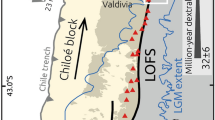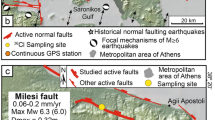Abstract
In order to understand the dynamics of the India–Asia collision zone, it is important to know the strain distribution in Central Asia, whose determination relies on the slip rates for active faults1,2,3,4,5. Many previous slip-rate estimates of faults in Central Asia were based on the assumption that offset landforms are younger than the Last Glacial Maximum (∼20 kyr ago)6,7,8,9,10,11. In contrast, here we present surface exposure ages of 40 to 170 kyr, obtained using cosmogenic nuclide dating, for a series of terraces near a thrust at the northern margin of the Tibetan Plateau. Combined with the tectonic offset, the ages imply a long-term slip rate of only about 0.35 mm yr-1 for the active thrust, an order of magnitude lower than rates obtained from the assumption that the terraces formed after the Last Glacial Maximum. Our data demonstrate that the preservation potential of geomorphic features in Central Asia is higher than commonly assumed.
This is a preview of subscription content, access via your institution
Access options
Subscribe to this journal
Receive 51 print issues and online access
$199.00 per year
only $3.90 per issue
Buy this article
- Purchase on Springer Link
- Instant access to full article PDF
Prices may be subject to local taxes which are calculated during checkout




Similar content being viewed by others
References
Avouac, J.-P. & Tapponnier, P. Kinematic model of active deformation in central Asia. Geophys. Res. Lett. 20, 895–898 (1993)
Peltzer, G. & Saucier, F. Present-day kinematics of Asia derived from geologic fault rates. J. Geophys. Res. 101, 27943–27956 (1996)
England, P. & Molnar, P. The field of crustal velocity in Asia calculated from Quaternary rates of slip on faults. Geophys. J. Int. 130, 551–582 (1997)
Holt, W. E. Correlated crust and mantle strain fields in Tibet. Geology 28, 67–70 (2000)
England, P. & Molnar, P. Active deformation of Asia: from kinematics to dynamics. Science 278, 647–650 (1997)
Peltzer, G., Tapponnier, P. & Armijo, R. Magnitude of Late Quaternary left-lateral displacement along the north edge of Tibet. Science 246, 1285–1289 (1989)
Peltzer, G. et al. Offsets of late Quaternary morphology, rate of slip, and recurrence of large earthquakes on the Chang Ma fault (Gansu, China). J. Geophys. Res. 93, 7793–7812 (1988)
Tapponnier, P. et al. Active thrusting and folding in the Qilian Shan, and decoupling between upper crust and mantle in northeastern Tibet. Earth Planet. Sci. Lett. 97, 382–403 (1990)
Gaudemer, Y. et al. Partitioning of crustal slip between linked active faults in the eastern Qilian Shan, and evidence for a major seismic gap, the ‘Tianzhu Gap’, on the western Haiyuan fault, Gansu (China). Geophys. J. Int. 120, 599–645 (1995)
Meyer, B. et al. Rate of left-lateral movement along the easternmost segment of the Altyn Tagh fault, east of 96°E (China). Geophys. J. Int. 124, 29–44 (1996)
Meyer, B. et al. Crustal thickening in Gansu-Qinghai, lithospheric mantle subduction, and oblique, strike-slip controlled growth of the Tibet plateau. Geophys. J. Int. 135, 1–47 (1998)
Molnar, P. & Tapponnier, P. Cenozoic tectonics of Asia: effects of a continental collision. Science 189, 419–426 (1975)
DeMets, C., Gordon, R. G., Argus, D. F. & Stein, S. Effect of recent revisions to the geomagnetic reversal time scale on estimates of current plate motions. Geophys. Res. Lett. 21, 2191–2194 (1994)
Project Idylhim members, Bilham, R., Larson, K. & Freymueller, J. GPS measurements of present-day convergence across the Nepal Himalaya. Nature 386, 61–64 (1997)
Van Der Woerd, J. et al. Uniform postglacial slip-rate along the central 600 km of the Kunlun Fault (Tibet), from 26Al, 10Be, and 14C dating of riser offsets, and climatic origin of the regional morphology. Geophys. J. Int. 148, 356–388 (2002)
Gillespie, A. & Molnar, P. Asynchronous maximum advances of mountain and continental glaciers. Rev. Geophys. 33, 311–364 (1995)
Washburn, Z. et al. Late Holocene earthquake history of the central Altyn Tagh fault, China. Geology 29, 1051–1054 (2001)
Bendick, R., Bilham, R., Freymueller, J., Larson, K. & Yin, G. Geodetic evidence for a low slip rate in the Altyn Tagh fault system. Nature 404, 69–72 (2000)
Tapponnier, P. et al. Oblique stepwise rise and growth of the Tibetan Plateau. Science 294, 1671–1677 (2001)
Bull, W. B. Threshold of critical power in streams. Geol. Soc. Am. Bull. 90, 453–464 (1979)
Molnar, P. et al. Quaternary climate change and the formation of river terraces across growing anticlines on the north flank of the Tien Shan, China. J. Geol. 102, 583–602 (1994)
Imbrie, J. et al. in Milankovitch and Climate, Part 1 (eds Berger, A. L. et al.) 269–305 (Reidel, Boston, 1984)
Thompson, L. G. et al. Holocene-late Pleistocene climatic ice core records from the Qinghai-Tibetan plateau. Science 246, 474–477 (1989)
Kohl, C. P. & Nishiizumi, K. Chemical isolation of quartz for measurement of in-situ-produced cosmogenic nuclides. Geochim. Cosmochim. Acta 56, 3583–3587 (1992)
Hetzel, R. et al. 21Ne versus 10Be and 26Al exposure ages of fluvial terraces: The influence of crustal Ne in quartz. Earth Planet. Sci. Lett. (submitted)
Kubik, P. W., Ivy-Ochs, S., Masarik, J., Frank, M. & Schlüchter, C. 10Be and 26Al production rates deduced from an instantaneous event within the dendro-calibration curve, the landslide of Köfels, Ötz Valley, Austria. Earth Planet. Sci. Lett. 161, 231–241 (1998)
Repka, J. L., Anderson, R. S. & Finkel, R. C. Cosmogenic dating of fluvial terraces, Fremont River, Utah. Earth Planet. Sci. Lett. 152, 59–73 (1997)
Hancock, G. S., Anderson, R. S., Chadwick, O. A. & Finkel, R. C. Dating fluvial terraces with 10Be and 26Al profiles: application to the Wind River, Wyoming. Geomorphology 27, 41–60 (1998)
Niedermann, S. The 21Ne production rate in quartz revisited. Earth Planet. Sci. Lett. 183, 361–364 (2000)
Dunai, T. J. Scaling factors for production rates of in situ produced cosmogenic nuclides: a critical reevaluation. Earth Planet. Sci. Lett. 176, 157–169 (2000)
Acknowledgements
R.H. acknowledges logistic support from the Chinese Academy of Sciences in Lanzhou and is grateful to J. Erzinger for his support. We thank B.P. Wernicke and G.S. Hancock for constructive reviews. This project is financially supported by the Deutsche Forschungsgemeinschaft, the Chinese Academy of Science (“Knowledge & Creativeness Project”), and the GeoForschungsZentrum Potsdam.
Author information
Authors and Affiliations
Corresponding author
Ethics declarations
Competing interests
The authors declare that they have no competing financial interests.
Supplementary information
Rights and permissions
About this article
Cite this article
Hetzel, R., Niedermann, S., Tao, M. et al. Low slip rates and long-term preservation of geomorphic features in Central Asia. Nature 417, 428–432 (2002). https://doi.org/10.1038/417428a
Received:
Accepted:
Issue Date:
DOI: https://doi.org/10.1038/417428a
This article is cited by
-
Late Quaternary Tectonic Activity and Slip Rates of Active Faults in the Western Hexi Corridor, NW China
Journal of Earth Science (2020)
-
The use of in-situ cosmogenic 21Ne in studies on long-term landscape development
Acta Geochimica (2018)
-
Holocene millennial-scale erosion and deposition processes in the middle reaches of inland drainage basins, arid China
Environmental Earth Sciences (2016)
-
Present-day slip-rate of Altyn Tagh Fault: Numerical result constrained by GPS data
Earth, Planets and Space (2014)
-
Holocene slip rate and paleoearthquake records of the Salt Lake segment of the Northern Zhongtiaoshan Fault, Shanxi Province
Science China Earth Sciences (2014)
Comments
By submitting a comment you agree to abide by our Terms and Community Guidelines. If you find something abusive or that does not comply with our terms or guidelines please flag it as inappropriate.



